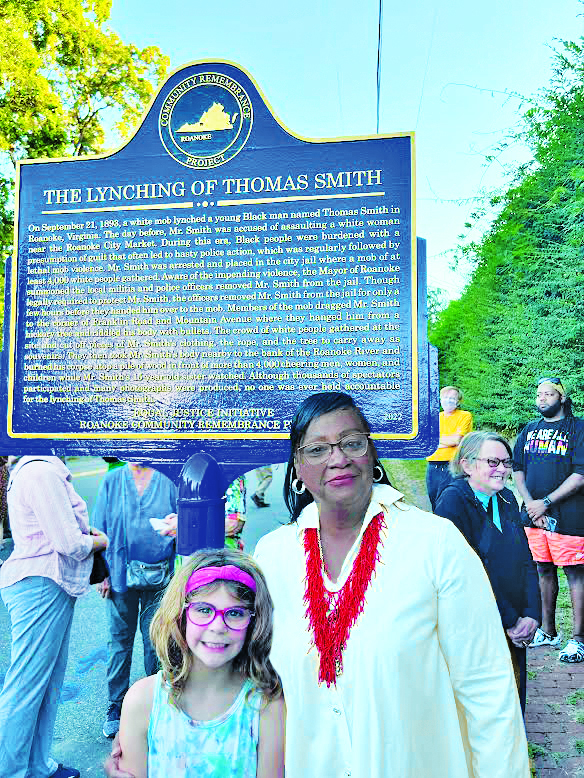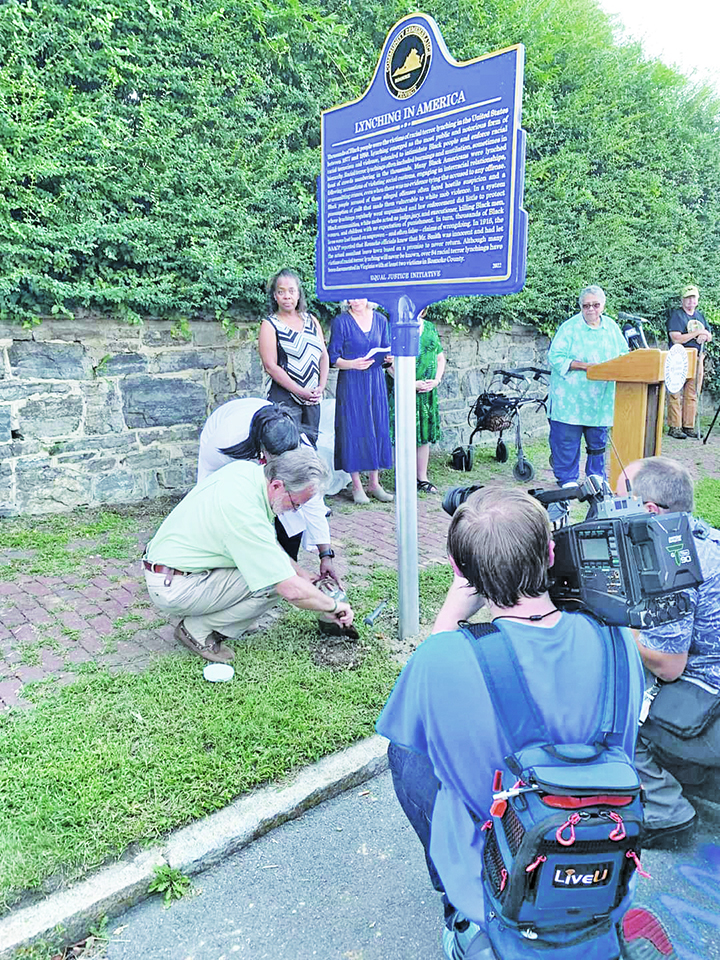by Brenda Hale, Chair, Local EJI-CRP

The Roanoke Equal Justice Initiative-Community Remembrance Project (EJI-CRP) hosted the long waited Marker Unveiling Ceremony Wednesday, Sept. 21 at the Corner of Franklin Road and Mountain Avenue where Thomas Smith, a Black man was lynched 129 years ago.
EJI-CRP organizers Dr. Brenda L. Hale, Rev. Dr. Amy Hodge, Jennie Waering, Councilman Bill Bestpitch, and Rev. Jen Brothers were joined by a special guest Teresa Scruggs, a relative of Thomas Smith. The event had over 225 observers which included members from 30 coalition partners of the Roanoke EJI-CRP. This diverse crowd was totally different from the 4,000-plus people (mob) that watched the horrific Lynching of Thomas Smith on September 21, 1893.
“Some have asked why we think recognizing and reckoning with the history of lynching in America is important,” said Councilman Bill Bestpitch, a major organizer of the project. “We want to ensure that everyone understands that the lynchings that have been part of our past must never be a part of our future. However, we live in a time when a white nationalist, neo-fascist hate group has the unmitigated gall to call themselves the Patriot Front. If they and others like them had their way, we could see lynchings again. That’s why I’m proud to stand here today with real patriots, with people who love our country enough to be willing to work together to make it better than it’s ever been.”
The councilman’s words christened what has ultimately become an incredible moment of historic significance for the area – as the city’s marker of atonement was unveiled to the applause of a crowd totally different from that of the 1800s – a crowd now standing up against the horrors of racism.
The jubilance of the moment was especially felt by the Roanoke EJI-CRP members and the coalition partners due to this having been a tedious 3-year venture leading up to the momentous unveiling.
“We never gave up hope of finding relatives of Thomas Smith or William Lavender,” said Dr. Hale, who chairs the local EJI-CRP.
While attending this year’s Henry Street Festival, Hale was approached by Teresa Scruggs who said her grandmother and great-grandmother were relatives of Thomas Smith. As such, Scruggs was encouraged to attend the unveiling at which she was welcomed with applause and cheering. She was emotionally overwhelmed at one point as she recounted what she knew based on her grandparents’ stories.
Rev. Dr. Hodge asked for a full minute of silence, after which she stated, “all of us must make peace with this, ALL of Roanoke City.”
The moment came as Councilman Bill Bestpitch, Rev. Hodge, Jennie Waering, and Teresa Scruggs each stood at a corner of the marker and proceeded to remove the protective covering, the crowd cheered and some were heard expressing how magnificent it was.
Deep colors of the marker’s gold lettering, set against a vivid blue background detail the unfortunate events that led to the gruesome truth that is the story of the hanging of Thomas Smith – a Black man who was precariously “presumed to be guilty” as the marker so states.

Following the unveiling Councilman Bill Bestpitch and Rev. Hodge collected a small amount of soil from the base of the marker. The gesture was in accordance with the exhibit of hundreds of lynching site soil samples and markers on display at what’s known as the Legacy Museum in Montgomery, Alabama.
The soil was collected in jars specifically labeled with Thomas Smith’s name on them. Another collection will be done from a site by the Roanoke River where they dragged Smith’s body, then burned it. The collection of soil will be sent to EJI Headquarters in Montgomery.
The museum, established in 2017 by EJI, opened in 2018 as a deeply moving exhibition that poignantly displays the history of slavery, racial lynchings, segregation, and racial bias in America. The museum so far has documentation of over 4,400 horrific lynchings in the United States and accounts of many others that may not be recognized.
The work continues for the Roanoke EJI-CRP as the story and marker for William Lavender, another who was locally lynched on February 12, 1892, must and will be told.





